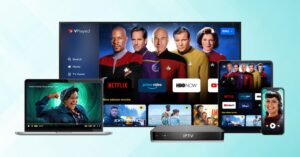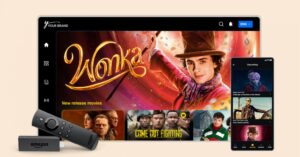
When it comes to online streaming, the terms “IPTV” and “OTT” frequently emerge, often creating a conundrum for organizations seeking the ideal streaming solution. While both play pivotal roles in the transition from traditional broadcasting to Internet-based streaming, they are actually distinct entities, each with its own set of characteristics of OTT vs IPTV.
Gone are the days of adhering to fixed TV schedules, as consumers seize the flexibility of on-demand content. According to Techjury, the shift away from cable and satellite TV is anticipated to be significant, with a projected 26% drop in penetration by 2030.
As we navigate this transformative phase, understanding the differences between IPTV and OTT becomes utmost important. The global OTT Video market is projected to reach a staggering US$295.40 billion by the end of 2023, with an estimated 7.30% annual growth rate leading to a market volume of US$420.10 billion by 2028 (Statista).
So, what sets these OTT and IPTV apart, and how can businesses choose the one that best aligns with their needs? For that, join us on this blog to uncover the nuances of IPTV vs. OTT and make an informed decision for the future of your streaming endeavors. Let’s get started!
What Is IPTV (Internet Protocol Television)?(visit the page)

What Is OTT (Over-The-Top)?(visit the page)

<br>In a world where acronyms abound, What OTT is, emerges as the superhero of modern streaming. But fear not, there is no need for a cape – just a good Internet connection. OTT delivers content directly to viewers via the Internet, bypassing traditional cable subscriptions. It’s like having your favorite show delivered to your doorstep without the intervention of a cable guy.
Now, let’s break it down further. OTT essentially means going above and beyond the traditional broadcast and cable providers, offering a more liberated viewing experience. OTT Platforms come in various forms, from OTT Streaming like Netflix to social media platforms hosting video content without the need for a satellite connection.
Unlike IPTV, which relies on dedicated IP networks, OTT makes the most out of the existing infrastructure. This means you can enjoy your favorite movies, series, or whatever on any device with Internet access – This be it on your smart TV, desktop, laptop, tablet, or smartphone.
How Does OTT Work?
OTT operates by delivering content directly to individual users over the Internet, allowing for a personalized viewing experience. Leveraging pre-recorded content stored in CDNs, OTT adapts to Internet speed, responds to user-initiated requests, and operates on a one-to-one transmission model, offering an affordable and user-centric alternative to traditional broadcasting.
- One-to-One Transmission Method
Unlike IPTV, which relies on broadcast-style transmission, Over-The-Top (OTT) operates on a one-to-one transmission method. This means that content is delivered directly to individual users over the Internet, allowing for a more personalized viewing experience.
- Pre-Recording and CDN Storage
OTT leverages the convenience of pre-recording content and storing it in Content Delivery Networks (CDNs). This strategic approach ensures that the content is readily available and can be efficiently delivered to the end user upon his/her request.
- Internet Connection Speed Dependency
The performance of OTT is intricately tied to the speed of the Internet connection. Faster connections translate to smoother streaming experiences, while slower connections may result in buffering issues. However, OTT Platforms adapt to network performance, dynamically adjusting the video quality to prevent prolonged buffering interruptions.
- User-Initiated Content Delivery
Unlike traditional broadcasting, OTT operates on a user-initiated model. The OTT platform responds to specific requests from customers, delivering content only when requested. This on-demand approach aligns with the modern viewer’s desire for flexibility and control over their entertainment choices.
- Affordable and User-Centric
OTT is often considered more affordable than Internet Protocol Television (IPTV), as it utilizes existing Internet infrastructure. The OTT model allows customers to stream one video to a single device at a time, promoting cost-effective and user-centric content delivery.
- ISP’s Role in OTT
When it comes to OTT, Internet Service Providers (ISPs) play a crucial role by providing the infrastructure through which OTT services stream content. Unlike IPTV, where the service provider manages the entire content delivery process, OTT places the responsibility on ISPs for the smooth conveyance of data.
- All in all, as we dissect the inner workings of OTT, the contrasts with IPTV become clearer, guiding us towards a more informed decision.
IPTV vs. OTT – Pros and Cons
As businesses and individuals traverse the continually evolving landscape of digital streaming, conducting a thorough analysis of the pros and cons of IPTV and OTT is essential for making a well-informed decision.
IPTV Pros:
Reliable Quality: IPTV distinguishes itself with broadcast-like quality, ensuring a consistent and reliable streaming experience. The dedicated network infrastructure minimizes interruptions, offering viewers a seamless and high-quality journey through their favorite content.
Dedicated Network: With IPTV, the luxury of a dedicated network ensures minimal buffering issues and smoother content delivery. This focused infrastructure allows for a robust and reliable transmission of live broadcasts and on-demand content, catering to the demands of the audience.
Interactive Features: IPTV goes beyond mere content delivery, offering interactive features like Video on Demand (VOD). This empowers users to exercise control over their viewing schedules, enhancing the overall engagement and satisfaction of the viewing experience.
IPTV Cons:
Infrastructure Dependency: Despite its advantages, IPTV’s reliance on a specific infrastructure can be a limitation. This dependency may restrict accessibility compared to the more versatile Over-The-Top (OTT) platforms, especially in regions with limited network infrastructure.
Higher Costs: While IPTV offers a premium streaming experience, the initial setup and ongoing maintenance costs can be a bit on the higher side. This factor may be a significant consideration for organizations or individuals operating within certain budget constraints.



#1 FIRST IPTV SUBSCRIPTION IN THE WORLD
Enjoy IPTV Service
Experience The Best IPTV subscription at competitive rates! Unlock access to over 18,000 live TV Worldwide Channels and 333,000 VODs. Stream in 4K from Anywhere on your all Devices!





